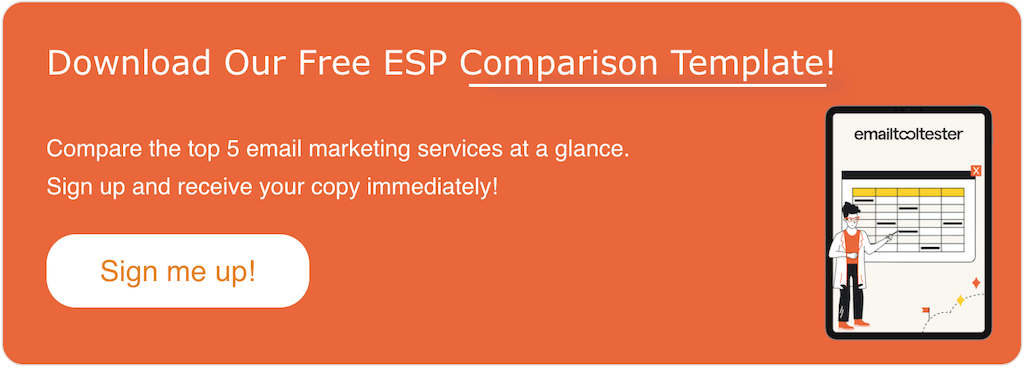EmailTooltester is supported by readers like yourself. We may earn a commission when you purchase through our links. Of course, this won't increase the cost for you.
Sometimes the world of email marketing can seem a little complicated. How do you make sure your subscription process won’t get you into legal trouble? How do you maintain your list of subscribers? And how do you even get subscribers in the first place?
We’re going to answer these questions (and a few more) in this article, alongside a step-by-step video on how to create and send newsletters.
Here’s what we’ll cover:
- What is an email newsletter?
- VIDEO – How do I create a newsletter?
- What features should I look for in professional email software?
- Email newsletter best practices (Plus some great newsletter examples!)
- A/B testing my newsletter
- How much does it cost to send a newsletter?
- Can I outsource my email marketing? (Yes, but it'll cost you)
- Do I need my own email server? (Short answer – no!)
- Legal considerations
- How do I get subscribers?
ESP: short for Email Service Provider. That's the software you use to manage your subscriber list(s), create, edit and send your newsletters and analyze the results. You'll also see us use the terms newsletter tool, email marketing software, email marketing service, newsletter service, email marketing platform and newsletter software, but they all essentially mean the same.
Template: an email template is a preformatted, customizable layout or design used for composing emails. It serves as a reusable framework for different uses, such as promotional emails, newsletters with multiple topics or transactional emails (e.g. payment receipts). Most newsletter tools come with pre-designed email templates that can be easily modified to fit your branding.
CTA: short for Call to Action, which is used to encourage a specific response or action from the reader, such as clicking a link or button within a newsletter or website.
Email Client: a software to send, receive, and organize email messages. Some popular email and webmail clients include Gmail, Outlook, Apple Mail, Thunderbird, and Yahoo Mail.
Autoresponder: an email autoresponder is a pre-written email messages that gets sent out in response to certain triggers or events. The trigger can be a newsletter sign up, which then will send a welcome email. Autoresponders can also be used to send follow-up emails or educational content in a series or sequence (often also called “drip emails”).
Landing Page: a landing page is a stand-alone web page. Usually, it shows a specific message or offer that its visitors can sign up for or purchase. Landing pages often hide classic website elements such as the navigation to reduce distractions. There are quite a few email service providers that have a built-in landing page editor (e.g. GetResponse and MailerLite).
What is an Email Newsletter (vs. Other Marketing Emails)?
Your first question might be: what is a newsletter? An email newsletter is an email that is sent out on a regular basis (e.g. weekly or monthly). It can be in HTML (displayed within a design) or in plain text format.
Newsletters are different from other types of marketing emails, such as autoresponders (e.g. welcome emails), transactional or triggered/automated emails. However, they can sometimes overlap. Each has an important part to play in any successful email marketing strategy, so newsletters should be used to complement these emails, rather than being an alternative to them.
Creating your email can be done simply through an email builder. The below example uses MailerLite's – it's really easy to use!
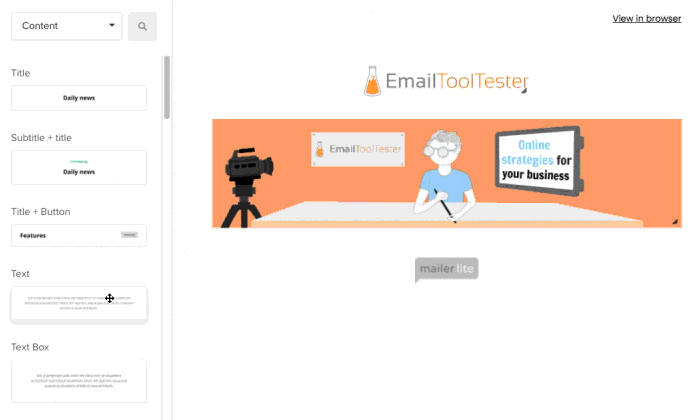
How to Create an Email Newsletter
Once you have the content locked down, you’d be surprised how simple the process of creating a newsletter in email format is! The following video shows you how an email newsletter is created, using two different email marketing tools as examples – MailerLite and ActiveCampaign.
As is the case with most providers, both offer a graphical editing interface. Using the drag and drop editor, you can add the building blocks you want to your newsletter. It’s incredibly easy, and you don’t need any programming skills.
How to send your first newsletter in 6 easy steps:
1. Sign up for an email service provider (ESP)
Choose an email service provider that meets your needs, whether you prioritize ease of use, advanced automation features, or affordability. For beginners, we generally recommend MailerLite and GetResponse for their generous free plans. Learn more about what to look for here.
Click here for some in-depth reviews on a variety of newsletter tools like Constant Contact, Mailchimp, Brevo and many more, or take our smart quiz below.
Smart Quiz: Use Our Interactive Tool
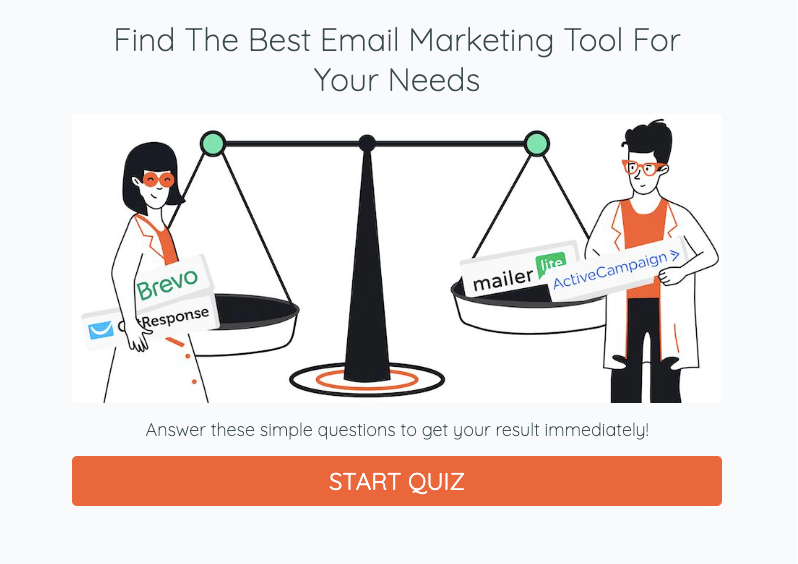
2. Import your newsletter mailing list (if you already have one)
Make sure your mailing list includes only subscribers who are either active customers of your business or have explicitly given you their opt-in to receive your newsletters. The upload of your contact list can usually be done as a CSV file or simply copying and pasting your contacts if it's a smaller list.
3. Set up your newsletter sign-up form
Make it easy for website visitors to sign up for your newsletter by creating a sign-up form that is prominently displayed and clearly communicates the value of subscribing. The form can be added to your website by pasting the form code from your email marketing software. There are usually also plugins available for WordPress websites and website apps for website builders like Shopify and Wix.
4. Set up authentication
To avoid your emails being caught by spam filters, make sure you set up common authentication methods like SPF, DKIM and DMARC. Your email service provider and domain registrar can help with that.
5. Set up your first email newsletter campaign
Determine the purpose and goals of your newsletter, create engaging content that resonates with your target audience, and design an eye-catching newsletter template that aligns with your brand. Keep these best practices in mind. Once your content is ready, upload with your newsletter editor.
6. Monitor the performance
Regularly review metrics like open and click-through rates to measure the popularity of your newsletter. Use A/B testing to experiment with different subject lines, content, and design elements to optimize performance.
What Features Should I be Looking for in Professional Emailing Services?
Now you know how to make a newsletter in 5 easy steps, what about the features of emailing software?
To run a newsletter mailing list, an absolute must is email list management. This will enable you to build and maintain a list of subscribers in a database and filter and sort them into groups. Depending on the software, integration into CRM systems may be possible, but it’s not always a simple task.
And then you’ll need an editor to create the newsletter. One of the features you’ll need is the ability to test the design in popular webmail and email clients (such as Outlook, Gmail, and Apple Mail).
Responsive newsletter templates are absolutely essential as more than half of all email newsletters are read on mobile devices these days. For this reason, you need to make sure your emails display well on smartphones using optimized email templates. If you're not keen on the templates provided by the ESP you choose, you can use a dedicated email template builder (most of which you can use for free!).
But don’t forget that you'll also need some well-defined processes, such as subscribing (ideally via double opt-in) and unsubscribing, as well as a way to deal with invalid email addresses. The best way to collect subscribers is through sign-up forms and landing pages.
All of the tools we review on EmailToolTester provide the above features – discover the best email marketing services here. Many people go straight to Mailchimp, but there is actually a whole range of excellent alternatives. Make sure to check these out before making your decision.
Deliverability rates are also extremely important. We’ve been running email deliverability tests for a number of years and can confirm that different newsletter services do have different deliverability rates. Of course, as a good marketer you should always follow best practices to improve deliverability like list cleaning and keeping subscribers engaged with high-quality content, but you also want a provider that takes deliverability just as seriously as you do! ActiveCampaign and MailerLite are our top providers in this area.
Email Newsletter Best Practices
Content:
Traditional newsletters (such as the print variety) tended to be more company-focused. They often contained company announcements, new product releases, awards, and other generally snooze-worthy information. Times have changed.
Put yourself in the shoes of the reader. If you had subscribed to your company’s newsletter, what sort of information would you want to see? And what would quickly make you hit ‘unsubscribe’?
The very best email newsletters we’ve seen (and the ones that usually perform better) feature content that’s relevant to the reader. Often, it’s information that’s:
- Useful – for example, tips, or links to ‘how to’ articles, tutorials or guides
- Visual – make it readable and visually appealing. Text-heavy emails just feel like work nowadays
- Timely – think of all the marketing you see around Superbowl, Coachella or at Christmas. There’s a simple reason for this: people are interested!
- Newsworthy – a recent development in your industry, for example, could make compelling content for your readers. For example, developments in artificial intelligence and the impact on your industry. By the way, ChatGPT can be an excellent help at finding new topics.
- Personal: People like to read stories. If something interesting happened to you that is also relevant for your readers, share it! This might be the most powerful type of content you can offer. It's also easy to create.
- Special offers, promotions and lead magnets – these can include sales, discounts, or even digital freebies such as ebooks and webinars.
- Events – if you've got an on or offline event coming up, let your subscribers know about it and how they can sign up!
- Personalized, tailored content – if your email tool allows this, you can send content based on the reader’s interests and preferences (think of Amazon’s ‘Products we recommend’ newsletters, based on readers’ purchases). It’s a strategy that actually works – research has found that personalization improves click-through rates by 14% and conversions by 10%.
Still not sure how to write a newsletter? Here are some newsletter examples and tips to help you with your email content.
Subject lines:
A good email subject line can mean the difference between your subscribers opening your newsletter or sending it directly to the trash. Here are some tips:
- Make it short and concise – about 50 characters is the ideal length, so you’ll need to be economical with your words. You can test yours with our subject line previewer
- Let the reader know they can expect to find inside – Don’t try to trick or mislead the reader as though this may get an open, it will most likely lead to them unsubscribing
- !!!!!! – Don’t get over-excited with punctuation and capitals. You don’t want the reader to feel like you’re screaming at them
Scheduling:
Don’t bombard your subscribers with emails, this will only result in them unsubscribing from your correspondence!
- Lay out a scheduling plan – you should avoid emailing your subscribers more than once a week. Once a month or bi-weekly is optimal – You can even ask your readers how often they’d like to receive emails from you
- Plan what you’re going to send in advance and schedule your email newsletters to go out at an optimal time – you might need to A/B test to see when this is (check out our guide on the best times to send newsletters to learn more)
- Keep your subscriber’s time zones in mind to avoid sending newsletters in the middle of the night
Drive readers to your site:
What’s the purpose of sending your contacts email newsletters? What action do you want them to take?
- Most likely you want to drive traffic to your website. Make sure the CTA (call to action) is clear. Add a button with a simple call to action, for example, you might tell readers you have a new blog post and add a button that links to this post that reads ‘Read Article’. I’d recommend having one clear goal as you don’t want to overwhelm readers
- Include social links – your footer should include links to your social media profiles. Most newsletter tools will have a specific content block where you can easily add this information
Keep an eye on metrics and test:
See what works and what doesn’t through A/B testing.
- What subject lines lead to a higher open rate?
- What CTAs drive more traffic to your site?
- What types of emails get the highest unsubscribe rate?
All of these tips should help you to get the most out of your marketing emails!
Note: Since Apple now allows users to block open rate tracking, we recommend using the click rate as your key metric. Though some email providers will provide you with an approximation, the click rate will actually give you a better idea of how your newsletters are converting.
Email newsletter examples
Netflix
Netflix newsletter example
Their newsletters are simple but brilliant. Check out this one promoting the last season of House of Cards, styled as an email from the president. It certainly grabs your attention! We also love that they regularly include animated GIFs from their TV shows within their email newsletters – what better way to bring their product to life?
Society6
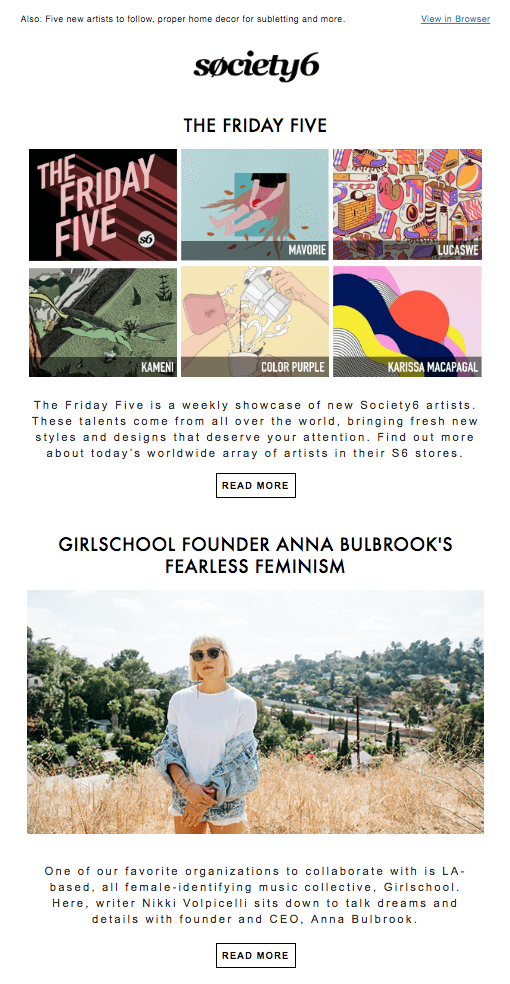
Society6 newsletter example
At EmailToolTester, we are suckers for good design, and that’s why we love online art retailer Society6’s newsletter. Each one feels handcrafted, with eye-catching illustrations and designs. There’s also plenty of interesting content for their artistically-inclined audience. We don’t even mind receiving their regular promotional emails, as they’re always so beautifully presented!
MOO
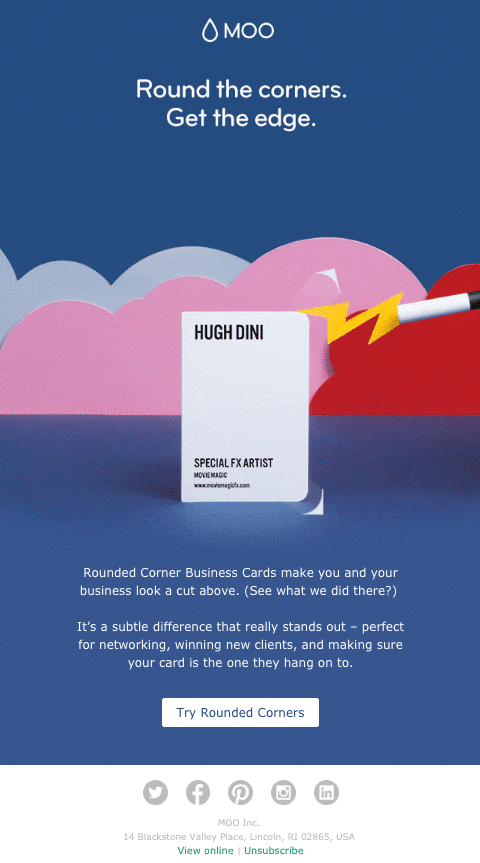
MOO newsletter example
B2B newsletters can often be pretty dull. MOO shows us that they can actually be pretty fun and dynamic by using a GIF. GIFs are a great way to engage your audience, especially if they're adding value to what you're trying to sell (i.e. not simply a cute dog).
What makes each of these newsletters work? It’s simple – each has been created with their specific audience in mind. Are your readers likely to be on-the-go? Make your email short and succinct. Are they more creative, visual people? Focus on design and images (and check out our tips on designing a newsletter that captures your readers' attention). And if you have multiple audiences, tailored newsletters is the way to go.
A/B Testing Your Email Newsletter
In order to boost your success rates, it’s a good idea to A/B test (or split test) your newsletters. This is a great way to test subject lines or calls-to-action and works by splitting a small, randomly selected subset of your mailing list subscribers into two groups.
Each of these groups will then receive one of the two emails, meaning that you can measure which is more popular and therefore use that one. Keep in mind that, for an A/B test to make sense, you should at least have 2000 subscribers on your list.
Most newsletter services offer this feature but it might be reserved for higher-tier plans, so make sure to look out for this.
How Much Does it Cost to Send out a Newsletter?
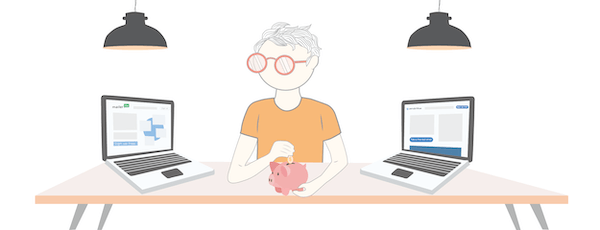
In theory, sending out HTML emails is free. You just open up your usual email client (e.g. Outlook) and you’re good to go. However, you’ll probably run into several problems pretty quickly. First of all, creating HTML emails in Outlook is rather complicated. And secondly, you have no means of analysis, or automating subscriptions or unsubscribes.
However, a good newsletter tool doesn’t have to be expensive. In fact, there are several providers who offer plans that are completely free. Even if you need expert features, and have an ever-growing subscriber list, your marketing budget may be able to cover this quite easily. For instance, if you want your email newsletters to reach 5,000 people in a month, you’re looking at somewhere between $25 and $45. And if your emails go out at irregular intervals, you can use a prepaid plan, meaning you only pay when you actually send out a newsletter.
Go ahead and check out our newsletter calculator if you want to get a better idea of how much email marketing might cost you! Just enter the number of emails you think you might want to send in a month, and the calculator will tell you what the most popular providers have to offer.
Can I Outsource my Email Marketing?
Yes, of course. There are different options. You can hire an email marketing agency, for example. Two of our team members have worked for such agencies in the past. It's the most professional way to do email marketing, but it comes at a high cost. Depending on how much you want to outsource (copywriting, campaign and artwork creation, project management etc.), it will cost several hundred Dollars per newsletter campaign, if not more.
A cheaper way, would be to hire a freelancer. To achieve that, you should check out platforms such as Upwork or Fiverr. There you can find professionals from all around the world with the skills you require. A big advantage of such hiring platforms is that you can see their previous ratings. However, you usually have to pay a fee to the marketplace if you manage to find someone.
Do I Need an Email Server of my Own to Send Out Email Newsletters?
A lot of components come together when sending out an email newsletter: a software or web application that creates the newsletter, and an email server that sends it out. Generally speaking, you’re free to manage each of these components separately. You can install the newsletter software on your server or client computer, and then use the email server provided by your web hosting provider (e.g. Namecheap or GoDaddy).
Unfortunately, most of these email servers aren't suitable for sending out a massive number of emails. Most servers shut you down when you try to send out several hundred emails in an hour. One way to deal with this issue is moving to an external SMTP server such as SMTP2GO or Brevo.
Another option, which is really more theoretical than anything else, is running your own email server. A quick cost/benefit analysis often makes this an unrealistic option for most small businesses. Sending out emails isn’t that much of a problem. However, if your email server doesn’t have a good sender reputation, your emails won’t be accepted by major email services such as Gmail, Yahoo, AOL, etc.
If you want to take the easy way out, you can opt for a hosted email system. Here, the provider doesn’t only give you access to the newsletter software – it also takes care of maintenance as well as deliverability for you. You'll often get some templates to start with, too. These kinds of newsletter tools are our focus here at EmailToolTester:
> Here’s a list of newsletter providers that don’t require an additional email server.
Legally Speaking, What do I Have to be Aware of When Using Email Marketing?
There are two legal concepts you should know about:
USA
The CAN-SPAM Act regulates the sending of commercial emails, emphasizing transparency, honesty, and the rights of recipients. While the Act doesn't specify a limit on the number of emails one can send, it operates on an opt-out principle. This means businesses can send commercial emails until a recipient chooses to unsubscribe.
Though the CAN-SPAM Act itself doesn't mandate proof of opt-in, most email service providers, like ActiveCampaign, Brevo and Mailchimp, have such requirements. They do this to maintain their reputation and the deliverability rates of their emails. A high frequency of spam complaints against a sender can lead to the email service provider's server or IP being blacklisted, which would impact all their users. Hence, providers are vigilant in ensuring that their users adhere to best practices.
Furthermore, the CAN-SPAM Act stipulates that every commercial email must contain a valid physical postal address, often placed in the footer of the email.
EU and Canada
In Canada, there’s a different principle. In this case, you need to be able to prove that the recipient explicitly subscribed to your newsletter. The best way of doing this is through a double opt-in procedure. Here, the subscriber receives a confirmation email with a link they have to click, in order to actually join the mailing list.
Countries within the EU take this even further. The introduction of the GDPR means that, aside from having double opt-ins in place, companies must be crystal clear in the language used on sign-up forms, and have defined procedures in place for processing and storing data (among other stringent requirements).
There are some exceptions – existing business relationships, for instance. If you have a current customer, you can usually send them emails without their explicit consent. If you want to find more information on legal questions regarding email newsletters, follow this link to read up on the legal situation in the USA, Canada, and the EU.
What about purchased email lists?
There are providers who try to sell you such lists and, in some cases, they even have opt-in proof that would hold up in a court of law. However, most email services we know of won’t let you use those kinds of lists. They don’t want to risk their good sender reputation, so they prohibit the use of purchased mailing lists. Statistics clearly show that the number of complaints is higher than the number of successful clicks for such lists.
So How do I Get People to Subscribe to my Email Newsletter?
In the long run, your best strategy is good content. If your newsletter content adds value to people’s lives in some way, they will talk about, and recommend it. So try and stay away from sales-driven advertising emails as much as possible. Instead, we recommend you use email marketing to invest in good customer relations.
You can also boost your subscription numbers by offering benefits: Our sister site, ToolTester, for instance, found out that offering a free ebook to every new subscriber caused significant growth (by a factor of ten in this case). A pop-up can get you even further – but be careful not to annoy your readers! Here are some additional tips to grow your subscriber list.
We have a whole guide on lead generation through email marketing – it's packed full of tons of tips and best practices, so be sure to give it a read when laying out your marketing strategy.
Next steps
All you need is the right provider?
> Here’s our newsletter tool comparison
More tips and tools can be found here:
> Take a look at our free email marketing resources
Download free newsletter templates here:
> 700 free responsive newsletter templates
We keep our content up to date
18 Apr 2024 - Shortened the article
23 Oct 2023 - Small update regarding CAN SPAM
17 Jul 2023 - Added smart quiz
20 Mar 2023 - Added definitions for commonly used terms
09 Mar 2023 - Updated the how to create a newsletter section
07 Feb 2023 - Added a tip about using AI
24 Nov 2021 - Added note about Apple's Mail Privacy Protection
08 Sept 2020 - Added Email newsletter best practices section
07 Sept 2020 - Updated content
27 Nov 2019 - A/B testing and deliverability section added
09 Nov 2018 - Information about outsourcing
15 Jun 2018 - GDPR section updated
31 Jul 2018 - Video added
Our Methodology
This article has been written and researched following our EmailTooltester methodology.
Our Methodology

